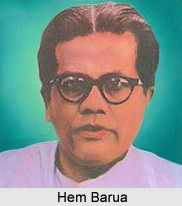 Assamese poetry in Jayanti era shows a sharp divergence from the optimism of the earlier period. Writers challenged the established norms and contentment of a society based on caste and class distinctions. Their poetry reflects a disillusionment and cynicism that stemmed from the knowledge that a free, modern India did not imply freedom and equality. Progress, technological and industrial, was felt to be doubtful if it ignored the concerns of a large part of society.
Assamese poetry in Jayanti era shows a sharp divergence from the optimism of the earlier period. Writers challenged the established norms and contentment of a society based on caste and class distinctions. Their poetry reflects a disillusionment and cynicism that stemmed from the knowledge that a free, modern India did not imply freedom and equality. Progress, technological and industrial, was felt to be doubtful if it ignored the concerns of a large part of society.
Among the poets of this generation, Amulya Barua (1922-46) was the foremost. His "An-dharor Hahakar" (The Tumult of Darkness) is a brilliant anti-romantic poem. It evokes the traditional Romantic image of an autumnal, moonlit night to have it reveal horror, death, and decay. His "Beisya" (The Prostitute) is a controversial poem that points contemptuously to the upper echelons of society who are united with the prostitute in a single act that they publicly scorn but privately practice. Where the prostitute`s behaviour arises out of dire need, the behaviour of the men is shown to be self-indulgent and thus more contemptible. In a similar vein, in Keshav Manama`s (1926) "Suror Koiphiyot" (The Thief`s Justification), which appeared in the first issue of Jayanti`s important seventh year, the protagonist, a thief, points at social conditions as being responsible for the path he must take. In the second issue of that year, Amulya Barua`s "Biplobi" (Revolutionary) explains the modern revolutionary vision, a vision that was not oppositional but sought ideological reforms through knowledge and tolerance. It was a bitter irony that the ignorance, intolerance and social divisiveness that Amulya Barua spoke out against were the cause of his death in the communal riots in Kolkata during partition. In the same issue of Jayanti, Hem Barua`s "Guwahati-1944" described the state of the nation as one crowded with wartime difficulties and political and ideological struggles.
The language of this poetry was immediate, accessible and extremely forceful. Its tone was questioning, probing, revealing. Among the notable poets of this period were Prasannalal Choudhuri, Shashikanta Gogoi, Bhaba Prasad Rajkhowa, Said Abdul Malik, Narayan Bezbarua, Mahesh Deb Goswami, Maheswar Neog, and Deva Kanta Barua, some of whom are still writing. It would be inaccurate to call all these poets anti-romantic, as many of them still leaned toward the earlier Romantics. But poetry in general showed the influence of English poets such as Yeats, Pound, and Elliot, and this modern poetry was the dominant one.













